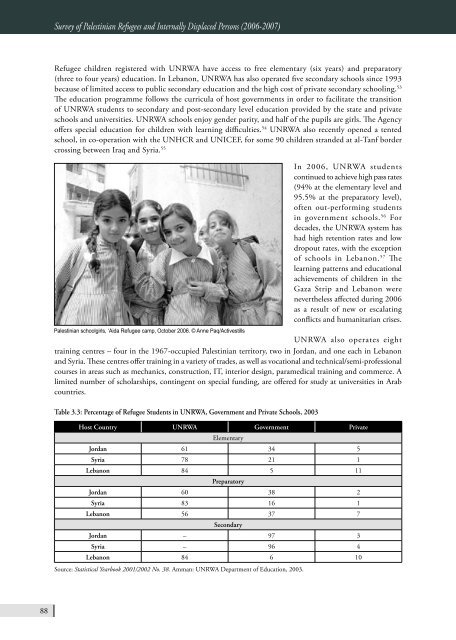BADIL Resource Center for Palestinian Residency and Refugee
BADIL Resource Center for Palestinian Residency and Refugee
BADIL Resource Center for Palestinian Residency and Refugee
You also want an ePaper? Increase the reach of your titles
YUMPU automatically turns print PDFs into web optimized ePapers that Google loves.
88<br />
Survey of <strong>Palestinian</strong> <strong>Refugee</strong>s <strong>and</strong> Internally Displaced Persons (2006-2007)<br />
<strong>Refugee</strong> children registered with UNRWA have access to free elementary (six years) <strong>and</strong> preparatory<br />
(three to four years) education. In Lebanon, UNRWA has also operated five secondary schools since 1993<br />
because of limited access to public secondary education <strong>and</strong> the high cost of private secondary schooling. 53<br />
The education programme follows the curricula of host governments in order to facilitate the transition<br />
of UNRWA students to secondary <strong>and</strong> post-secondary level education provided by the state <strong>and</strong> private<br />
schools <strong>and</strong> universities. UNRWA schools enjoy gender parity, <strong>and</strong> half of the pupils are girls. The Agency<br />
offers special education <strong>for</strong> children with learning difficulties. 54 UNRWA also recently opened a tented<br />
school, in co-operation with the UNHCR <strong>and</strong> UNICEF, <strong>for</strong> some 90 children str<strong>and</strong>ed at al-Tanf border<br />
crossing between Iraq <strong>and</strong> Syria. 55<br />
<strong>Palestinian</strong> schoolgirls, ‘Aida <strong>Refugee</strong> camp, October 2006. © Anne Paq/Activestills<br />
UNRWA also operates eight<br />
training centres – four in the 1967-occupied <strong>Palestinian</strong> territory, two in Jordan, <strong>and</strong> one each in Lebanon<br />
<strong>and</strong> Syria. These centres offer training in a variety of trades, as well as vocational <strong>and</strong> technical/semi-professional<br />
courses in areas such as mechanics, construction, IT, interior design, paramedical training <strong>and</strong> commerce. A<br />
limited number of scholarships, contingent on special funding, are offered <strong>for</strong> study at universities in Arab<br />
countries.<br />
Table 3.3: Percentage of <strong>Refugee</strong> Students in UNRWA, Government <strong>and</strong> Private Schools, 2003<br />
Host Country UNRWA Government Private<br />
Elementary<br />
Jordan 61 34 5<br />
Syria 78 21 1<br />
Lebanon 84 5 11<br />
Preparatory<br />
Jordan 60 38 2<br />
Syria 83 16 1<br />
Lebanon 56 37 7<br />
Secondary<br />
Jordan – 97 3<br />
Syria – 96 4<br />
Lebanon 84 6 10<br />
Source: Statistical Yearbook 2001/2002 No. 38. Amman: UNRWA Department of Education, 2003.<br />
In 2006, UNRWA students<br />
continued to achieve high pass rates<br />
(94% at the elementary level <strong>and</strong><br />
95.5% at the preparatory level),<br />
often out-per<strong>for</strong>ming students<br />
in government schools. 56 For<br />
decades, the UNRWA system has<br />
had high retention rates <strong>and</strong> low<br />
dropout rates, with the exception<br />
of schools in Lebanon. 57 The<br />
learning patterns <strong>and</strong> educational<br />
achievements of children in the<br />
Gaza Strip <strong>and</strong> Lebanon were<br />
nevertheless affected during 2006<br />
as a result of new or escalating<br />
conflicts <strong>and</strong> humanitarian crises.

















